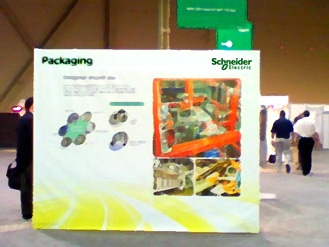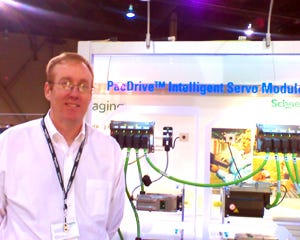March 11, 2015

 POST A COMMENT
POST A COMMENT
At Initiative 2008, a multi-industry trade conference and exposition hosted by Schneider Electric, Packaging Digest met up with the company’s North America operating division packaging market segment manager W. Jarrett Campbell Ph.D., who outlined what he sees as the top-three challenges and opportunities facing packaging machinery builders:
labor shortages
machinery simplification
line performance
According to Campbell, there is a very real labor crisis in the U.S. for skilled packaging machinery engineers who truly understand mechanical motion systems and can keep these systems running. He notes that packaging machinery component suppliers—such as his employer Schneider Electric—can help the industry deal with labor shortages by simplifying how the machines work and helping standardize machine builders how the machines’ operation. “Not only does it save labor costs upfront, it translates into simplification in support for the end-user,” Campbell explained.
He cites the support efficiency of servo motors with memory capabilities as an example. “You can take one of our servo motors and take it off, plug in a new one and it automatically downloads all the parameters from the controller to the motor,” Campbell comments. “So, you basically can replace a faulty motor by snapping it off, take it a new one and snapping it on, hit the button on the screen, and you are going again.”
Campbell also noted the importance of simplification on the software side of the packaging design process and suggested a two-pronged approach to software simplification: standards compliance and taking advantage of modular software-writing tools. By adhering to standards, e.g., Make@Pack and PackML, being developed by organizations such as the OMAC Packaging Workgroup, suppliers and machine builders can program their machines in way that can be more easily supported by the packaging operations. “End users are getting machines from different vendors, and their technicians know the standards.” he remarks. “Having a common way of how the machines need to work helps one person support all of them.” Campbell points out that software with pre-written modules can not only help packaging machinery builders adhere to these standards, the modules also can shorten the overall time needed to write the machinery’s software.
He also argues, sensibly enough, that packaging machinery not only needs to be easy to support—it also needs to have high levels of performance. Key to the high performance required of these machines is a high level of precision. “When we are talking about putting labels on cans of food at speeds of 10 per second, you have to be very precise” Campbell comments. “The performance needed on the automation systems is critical.” Packaging machinery builders, he says, can both increase precision and simplification by using automation systems that can synchronize a high number of axes of motion with a single CPU.
Related podcast:'Greening' packaging operations can start as early in the process as the building of the line machines themselves. In this podcast, Schneider Electric's North America operating division packaging market segment manager W. Jarrett Campbell Ph.D. chats about how manufacturers can build greener machines.
About the Author(s)
You May Also Like


